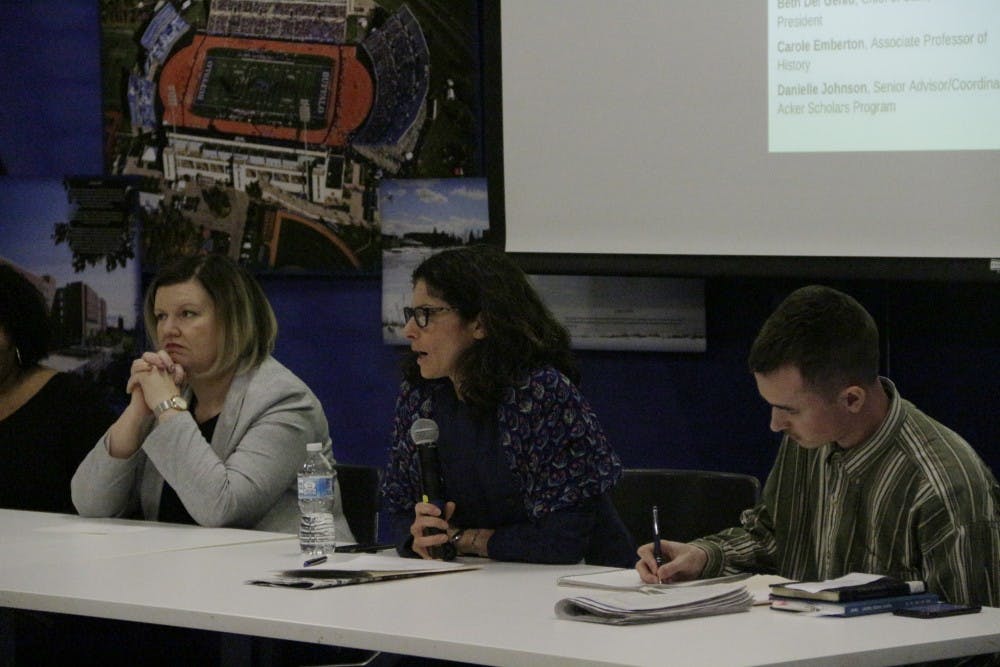UB community members discussed the naming of university landscapes, which are sometimes named after people with complicated pasts, during Wednesday’s DIFCON panel.
Four UB community members participated in the panel discussion, which came before a question-and-answer session. The panelists included Benjamin Blanchet, editorial editor for The Spectrum, Beth Del Genio, chief of staff for UB President Satish Tripathi, Carole Emberton, an associate history professor and Danielle Johnson, a senior adviser for the Daniel Acker Scholars Program.
The panel discussed UB’s building and space names and the ways the university commemorates people with difficult legacies. Panelists said issues “come and go” with the students who care and the topics discussed are not merely problems of the past, but reflect current social conflicts as well.
Emberton, who wrote an article for The Washington Post about Millard Fillmore’s involvement in the Fugitive Slave Act of 1850, talked about similar conversations at Georgetown University and the University of North Carolina. She talked about the different ways in which university faculties at the two universities responded to the situations.
Emberton said she asked her students to submit ideas for how UB could respond to the Fillmore’s commemoration. She said her students talked about how UB should create spaces that memorialize the victims of historical figures’ difficult pasts, which she said was a similar response to those at Georgetown University.
Del Genio said the response of the university should include “contextualizing” certain names and memorials, removing them entirely or finding a “more appropriate” setting for them.
Del Genio also said it was important to “keep in mind” the political and social landscape of the time that the controversial figures were living in.
“Remember, the response needs to be proportionate,” Del Genio said. “Proportionality is going to be important in the conversation because the response must be proportionate to the underlying laws that were connected.”
Blanchet talked about his experience investigating and writing about the naming process on campus, as well as the lack of representation for women and minorities in campus namesakes.
“At least 21 spaces are named after people of color, three to my knowledge have Native American ties, 26 are for women and 185 are for men,” Blanchet said.
Blanchet also noted how many community members are unaware of the history of the people these buildings are named after.
Johnson talked about the importance of preserving black history in Western New York and detailed the efforts of people like Mary Talbert — who Talbert Hall is named after.
She gave an anecdote about her “powerful” experience visiting the tombstones of Mary Talbert and Daniel Ackers, which made her realize the legacy of these figures was not limited to names on a building.
“To see where they were laid to rest made them real,” Johnson said. “They weren’t just namesakes, they were real people.”
A member of the audience raised similar concerns about the legacy of the people buildings are named after during the Q&A session, and talked about how current faculty members may have “happy memories” of UB’s 13th president William R. Greiner — who Greiner Hall is named after –– but most students living in that building don’t know who Greiner was.
Members of the panel including Emberton and Despina Stratigakos, vice provost for inclusive excellence, proposed implementing a class which would teach students the history of UB.
Another member of the audience talked about Kapoor Hall on South Campus, which is named after UB alum John Kapoor. Kapoor is currently on trial in Boston for his alleged involvement in the U.S. opioid crisis.
The audience member said students may be unaware of the controversial past of figures such as Millard Fillmore, who died in 1874, but are definitely aware of the allegations against Kapoor.
The audience member said it was “detrimental” to have Kapoor’s name on university property.
Many people have questioned whether the university would rename Kapoor Hall given his alleged involvement in the crisis, but Del Genio said university administration decided to “allow the judicial process to determine” his involvement as they believed that was “the right thing to do.”
Stratigakos pointed to the success of the Revolution exhibition in the Silverman Library, and said students were more likely to pay attention and remember the exhibition since it is in such a prominent position at the school.
Stratigakos said she hoped to make funds available through her office, which would allow resources to make “exhibitions or art installations” that would commemorate the history of UB community members.
Tanveen Vohra is a Co-senior News Editor and can be reached at Tanveen.vohra@ubspectrum.com and on Twitter @TanveenUBSpec.
Tanveen Vohra is a former senior news editor and covered international relations and graduate student protests.






